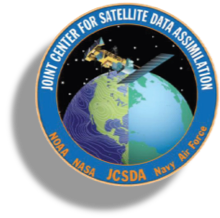What is your role at JCSDA? What does that involve?
TS: I’m the SOCA project lead: we deal with data assimilation in the ocean, which also includes sea ice, biogeochemistry, and someday waves. We’ll eventually be doing a lot more. Day to day that involves making sure the existing SOCA program is running well and getting the operational quality ocean data assimilation system ready for NOAA and NASA. First up is NOAA; the code freeze for that is the end of this year. It’s exciting because other than CRTM it will be one of the first parts of JEDI to be used in operations. Right now we’re making small improvements so NOAA can do their testing. The current operational system was last updated in 2003, so SOCA will be a huge improvement.
What is your favorite part of the work you’re doing?
TS: Once you get to higher and higher resolutions you start seeing these small eddies, and it’s really fun to run a one-month simulation and watch all of them swirl around. I’m excited for next year when we’ll go from ¼ degree resolution to 1/12 degree resolution, we’ll be seeing a lot more of those. It will be especially exciting once we start assimilating ocean color, that makes some really pretty swirls. So the best part of my day is when we have pretty animations that look cool.
What brought you into the field? What has your career path been like?
TS: Originally, back in undergrad, I was a computer science major and I wanted to do video games. But it’s a hard industry to get into. At a career fair somebody from the Navy showed me their flight simulator, which was kind of like a video game. So I ended up taking a job with the Navy at Pax River in Maryland working on the flight simulators, which was pretty cool! They would take any aircraft that had too hard of a landing and shouldn’t fly anymore and chop off the front of it, then hook it up to the computers so the airplane thought it was still flying. We were working on 2-3 million dollar cockpits, and we would “test our code” all the time. I got to work on jet aircraft, helicopters, and missile simulators. But eventually I got bored with that, so I told myself that I would apply to grad school when my wife, who was currently in med school, applied to residencies. I went with University of Maryland, where a friend of mine had a roommate in atmospheric science who was doing this weird thing called data assimilation; that’s how I found out about it. I thought it sounded interesting, lots of HPC and things like that. So I focused on atmospheric and ocean science during grad school. I never actually took an oceanography course, but I did research on ocean and atmospheric DA and worked at the Climate Prediction Center (CPC) for 2 and a half years while I finished my PhD, basically did my post doc before I finished my PhD. I implemented an ocean DA system for them because they were tired of waiting for a new one. Then I heard about this position at JCSDA and applied. We kept doing the same kind of work I’d been doing at CPC, but with this new system called SOCA. I had a long road just basically following whatever my interests are, never really planning too far ahead, and it worked out. But I should probably take an oceanography course someday.
What are you most excited about in the field right now?
TS: I’m looking forward to wave DA. There’s a lot of really cool research where people are looking at the waves and wave spectra and it can tell you about the ocean floor. Like if a hurricane comes through and they need to send ocean rescue teams and the ocean bottom has changed, you can infer the new bottom based on the waves. Also coupled DA–my dissertation was on coupled LETKF, using atmosphere observations in the ocean and ocean observations in the atmosphere. It’s fun stuff, especially when you’re dealing with ensemble forecasts and you can pick out the correlations. I think it will be really interesting to see what we can do in the next couple of years with JCSDA’s Skylab experimental testbed in terms of using observations in new and exciting ways that haven’t been done before–can the waves tell me what the atmospheric winds are or what the ocean mixing is? The phrase coupled DA has been thrown around a lot, but I think we finally have a chance to do some cool science with it.
What do you do for fun outside of work?
TS: Right now I have two kids and I’m trying to finish up remodeling, so not that much. When I have free time I’m into gardening. This past year we grew 55 pounds of tomatoes in our tiny garden. Fine woodworking, trying to do as much as I can with wood without using electricity. Cabinetry, furniture, things like that. Despite being a computer programmer my hobbies tend to go towards low-tech, off the grid kind of things. I want to do things the hard way. I used to brew beer, but I don’t have time for that anymore–you don’t need to in Colorado anyway. My wife and I are starting to get into D&D, we like those types of complicated games. I used to collect butterflies, I started back in elementary school–collect them, pin them, label them. My son is actually into butterflies now, which is exciting. The Denver Nature and Science Museum has the most beautiful pinned butterflies I’ve ever seen.


